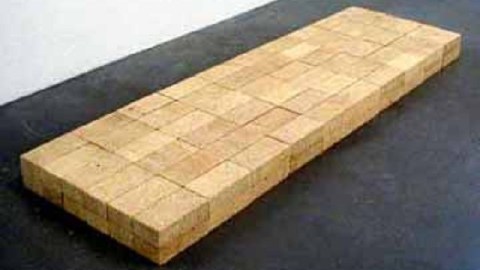Is Contemporary Conceptual Art a Fraud? This Conceptual Artist Thinks So

“Humbug,” harrumphed Minimalist/Conceptual artist Carl Andre recently in response to a question about Conceptualism in art today. “I think it is humbug myself,” Andre announced, channeling his inner Ebeneezer. “That is my own private opinion… I just don’t believe in Joseph Kosuth’s slogan ‘art as idea as idea’—if it is an idea it has never entered the world.” Surprising words from a surprising source, Andre’s pronouncement on the state of contemporary Conceptualism presents art critics and museums with the odd predicament of defending a school of contemporary art from one of the founding figures of the school itself. If we take Andre at his word, is it time to consider whether contemporary Conceptual art really is (as non-Dickensian Americans would call it) a fraud?
Andre found himself a forum in British paper The Telegraph as part of the coverage of a retrospective of his sculpture from 1967 through 1983 at the Turner Contemporary titled Carl Andre: Mass & Matter. The “humbug” moment came on the heels of a short discussion of Andre’s signature sculpture Equivalent VIII (The Bricks) (shown above), which brought down an avalanche of criticism when the piece was purchased in 1972. Purchased by the Tate for £2,297 in 1972, “The Bricks” weighed heavily on the institution as rumors of soaring prices (up to and sometimes beyond a million pounds) brought public ire. (A similar work by Andre actually did garner £1 million, so perhaps the Tate got a deal.) Why pay anything for a load of bricks arranged on a floor beyond the actual market price of the bricks? One “critic” went so far as to splash a bucket of blue dye on the bricks. To their credit, the Tate stood firm in the face of public and critical opposition and defended Andre and Equivalent VIII unequivocally.
And, yet, here is Andre doing basically the same thing 40 years later—not to his own work, but to that of others, specifically “these kids today.” Perhaps Andre’s separating his work from the Conceptualists by calling himself a Minimalist, but what’s Minimalism without the “concept” of what a pile of bricks might mean, or ask the viewer to consider what it might mean, or question the very nature of meaning itself? If he is, Andre’s only fooling himself. Or perhaps this is all a Conceptual art piece itself—a Conceptualist decrying Conceptualism to make the critics and public rise to his defense? If Andre’s playing “Devil’s Advocate,” then he’s playing it exceedingly well.
But if Andre’s serious, I think he’s inadvertently hit upon what’s wrong with Conceptualism. It’s not a “humbug” in the sense of perpetrating a fraud on the public. It’s a “humbug” in the sense that it would use words such as “humbug.” In striving to be all things Duchamp, they’ve forgotten the core tenet of being Marcel—have fun! The MFA-ification and October-izing of modern artists has squeezed the last ounce of humor from much of modern contemporary art, particularly Conceptualism, which really should get out and play much more often. Duchamp recognized the grim face of modern existence and painted a mustache on it. Today’s artists should look back at “The Bricks” and its story (if not Andre himself) as an example of Conceptualism as the “Brick house” of contemporary art, where the “Mighty might just lettin’ it all hang out.” Instead of throwing bricks at younger artists, Carl Andre should be getting’ down with them.
[Image:Carl Andre. Equivalent VIII (The Bricks), 1966.]





